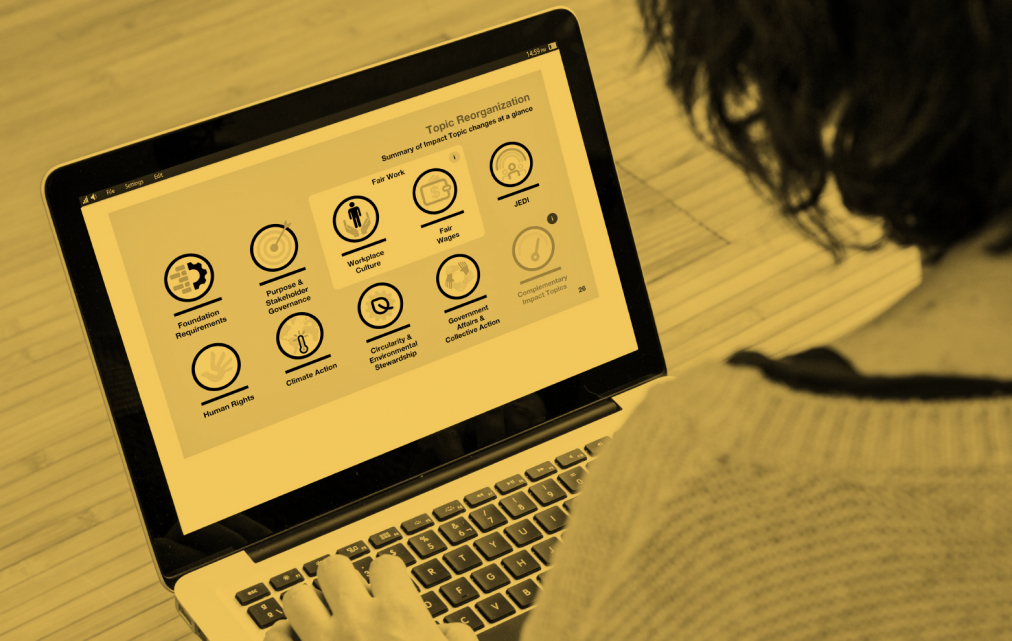Building a Better B Corp


“I feel good about the new standards and it starts with having the overview, as it is overwhelming but we can work through it step by step.”
The time is now to put a plan in place to exceed B Lab’s new performance standards with confidence and calm.

The report from the second consultation on the new B Corp performance standards was issued recently and wonks like me jumped straight into the detail. I was delighted where anticipated changes had been made (Complementary Impact Topics) and straining to guess the next move where threads have been left untied (living wage and setting transparent goals). Kudos to B Lab Global on the professionalism and transparency of this consultation process. The long, exhaustive process leaves B Leaders like me chomping at the bit to get V6 archived and these standards rolled out.
The new performance standards signify a huge departure from the six previous versions of the standards that have allowed the movement to bloom in the preceding 16 years. The free tool that B Lab originally published in 2006 remains, to this day, the world’s best for comprehensively analysing an organization’s gaps in sustainability, and holding up a mirror to business practices and parts that others have yet to consider. Yet its language and accessibility began to stutter in recent years as technology and politics brought a global lens to material issues and the US filter began to feel outdated. (B Lab was founded in America and is headquartered there.)
The new (draft) standards pull back and focus on equity and inclusivity, they lay down best-in-class minimum requirements, and take a grown-up management approach to measuring and evidencing impact. They are now themed across eight Impact Topics;

Here are three examples of the minimum requirements organizations will have to meet:
These three requirements, all from different impact topics, have the engagement and well-being of stakeholders, or rights-holders, at their heart.
…we all have a right to well-being that’s free from harm by corporate activities — or, ideally holistically enhanced by company influence. (From Shareholders to Stakeholders — to Rightsholders: Why the Shift? By Ralph Thurm & Bill Baue)
A double materiality assessment is an absolutely essential process for meeting multiple stakeholder engagement requirements across the standards. It is also an essential test of the assumptions at the heart of your strategic approach to sustainability, and your impact on stakeholders (people and planet). Take the time to run through a double materiality process before you try to meet the requirements of the new standards to gain a deep understanding of your negative and positive impacts.
And if, like Junxion, you’re truly committed to making the leap to the purpose economy, consider this: a social purpose business strives to make an optimal, strategic contribution to the long-term well-being of all people and the planet. So rather than merely managing negative outcomes, it contributes to positive ones. This approach makes for an exceptional B Corp, exceeding requirements.
This year I have delivered new standards improvement plans to clients committed to B Corp certification and keen to prepare to meet the new standards in time for their [re]certifications in 2026. The time is now to take an overview of the 25 – 30 minimum requirements (not including your Impact Business Model) across the Impact Topics, and then to step into the detail, focusing on where you will need data from your 2025 fiscal year in order to submit.
You will likely need to prepare half a dozen strategic or process papers around your approach to topics like the climate transition; human rights; purpose and justice; equity, diversity and inclusivity. These must be written, approved, implemented, and evidenced, B Lab’s approach has grown systematic and mature. You’ll need to showcase your implementation and performance with an annual impact report, for which best practice would be to adhere to an accepted standard such as the GRI.
Having taken different working groups of professionals through a process to review and prioritise these requirements, I know that time is needed to familiarise colleagues with the language, the approach, and the high performance standards incorporated in this evolution. For large organizations, many requirements will need to be delivered in partnership with Human Resources or People Team leads.
Instead of landing it on their desks six months before submission is due, socialise it with them now, review the things that seem impossible and can’t be done…yet. Triage the actions and develop project plans so that your teams feel inspired by the detail and ambition inherent in these standards and not overwhelmed.
It’s working for our clients …
“I feel good about the new standards and it starts with having the overview, as it is overwhelming but we can work through it step by step.”
With that, I leave you with Moloko’s sage lyrics:
And we gave it time
All eyes are on the clock
But time takes too much time
Please make the waiting stop
And the atmosphere is charged
In you I trust
– Moloko
Overwhelmed by the new B Corp Standards or want to submit under the current standards, now, to lay a foundation for meeting the new standards? We’re here to set you up for success in good time. Get in touch.
